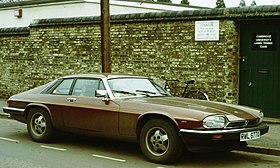Jaguar XJ-S
| Jaguar XJ-S | |
|---|---|
 |
|
| Overview | |
| Manufacturer | Jaguar Cars |
| Production | 1976–1996 |
| Assembly | Coventry, England |
| Body and chassis | |
| Class | Grand tourer (f) |
| Layout | FR layout |
| Chronology | |
| Predecessor | Jaguar E-Type |
| Successor | Jaguar XK8 |
| XJ-S (Pre H.E.) | |
|---|---|
 |
|
| Overview | |
| Production | 1976–1981 14,800 built |
| Body and chassis | |
| Body style | 2-door coupé |
| Powertrain | |
| Engine | 5.3 L Jaguar V12 |
| Dimensions | |
| Wheelbase | 102 in (2,591 mm) |
| Length | 191.72 in (4,870 mm) |
| Width | 70.6 in (1,793 mm) |
| Height | 50 in (1,300 mm) |
| XJ-S H.E., 3.6, XJ-SC | |
|---|---|
 |
|
| Overview | |
| Production | (All engines, including H.E. and 3.6) 1982-1991 73,207 built Coupé: 55,822 Targa / convertible: 5,013 Full convertible: 12,372 |
| Body and chassis | |
| Body style | 2-door coupé 2-door targa convertible (1983-88, V12 from 1985) 2-door full convertible (from 1988) |
| Powertrain | |
| Engine | 3.6 L AJ6 I6 5.3 L HE V12 |
| Transmission | 5-speed manual (3.6 only) 3/4-speed automatic |
| Dimensions | |
| Wheelbase | 102.0 in (2,591 mm) |
| Length | 191.7 in (4,869 mm) |
| Width | 70.6 in (1,793 mm) |
| Height | 47.8 in (1,214 mm) |
| XJS (Facelift) | |
|---|---|
 |
|
| Overview | |
| Also called | Jaguar XJS Classic |
| Production |
1992–1996 27,406 built Coupé: 8,832 Convertible: 18,574 |
| Body and chassis | |
| Body style | 2-door coupé 2-door 2-seat convertible 2-door 2+2 convertible |
| Powertrain | |
| Engine | 4.0 L AJ6 I6 4.0 L AJ16 I6 5.3 L HE V12 6.0 L HE V12 |
| Transmission | 5-speed manual 4-speed automatic |
| Dimensions | |
| Wheelbase | 102.0 in (2,591 mm) |
| Length | 191.2 in (4,856 mm) |
| Width | 1992—1993: 70.6 in (1,793 mm) 1994—1996: 74.1 in (1,882 mm) |
| Height | 48.7 in (1,237 mm) |
The Jaguar XJ-S (later XJS), a luxury grand tourer, was produced by the British manufacturer Jaguar from 1976 to 1996. The XJ-S superseded the E-Type (also known as XK-E) in September 1975, and was based on the XJ saloon. It had been developed as the XK-F, though it was very different in character from its predecessor. Although it never had quite the same sporting image, the XJ-S was a competent grand tourer, and more aerodynamic than the E-Type. The last XJS was produced on 4 April 1996; by then 115,413 had been produced during a 21-year production life. The model was replaced by the XK8.
The XJ-S was launched on 10 September 1975. The development of the car had begun in the late 1960s as project XJ27, with an initial shape set by Malcolm Sayer, but after his death in 1970 it was completed by the in-house Jaguar design team, headed by Doug Thorpe. Power came from the Jaguar V12 petrol engine with a choice of a manual or automatic transmission, but the manual was soon dropped as they were left over from V12 E Type production. V12 automobiles were unusual at the time; Italian luxury sports car makers Lamborghini and Ferrari produced such models. The specifications of the XJ-S compared well with both Italian cars; it was able to accelerate to 60 mph (97 km/h) in 7.6 seconds (automatic) and had a top speed of 143 mph (230 km/h). The first series of XJ-S cars had a Borg-Warner Model 12 transmission with a cast-iron case and a bolt-on bell-housing. In 1977 GM Turbo-Hydramatic 400 transmissions were fitted. The TH400 transmission was an all-aluminium alloy case with an integrated non-detachable bell-housing. The XJ-S was originally supplied with Dunlop SP Super E205/70VR tyres on 15 × 6K alloy wheels; British police upgraded their Jaguars to a higher-performing 205/70VR15 Michelin XWX .
Jaguar's manufacturing timing was not good; the car was launched in the wake of a fuel crisis, and the market for a 5.3-litre V12 grand tourer was very small. The styling was also criticised, including the buttresses behind the windows. German authorities feared these would restrict rearward vision, and refused to give the XJ-S, and the similarly adorned Lancia Montecarlo, type approval: it was for a time necessary instead for German XJS buyers to obtain type approval for each individual car when registering it. Such fears were ill-founded, since in reality the rear visibility was very reasonable, with only the frontmost top edges of the buttresses being visible when looking rearward.
...
Wikipedia
